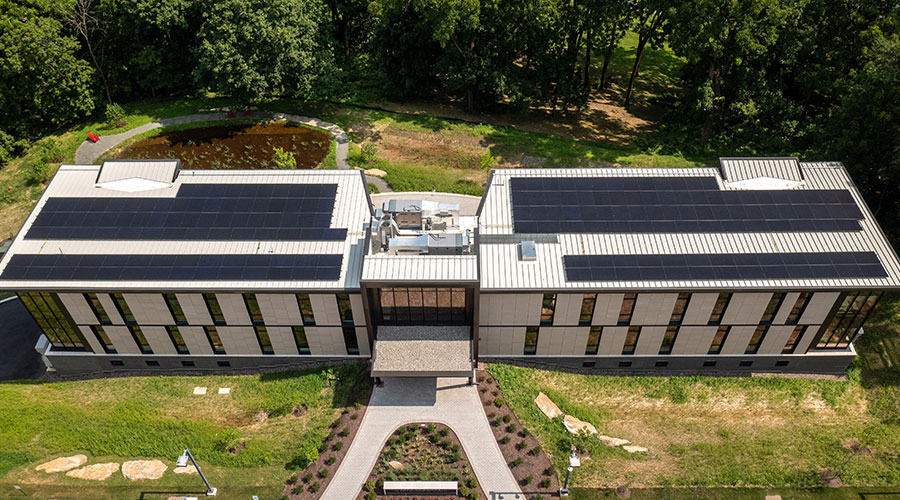Managing Assets — When They’re Overhead
Comprehensive roof maintenance programs improve system performance and are cost-effective in the long run
No facility executive wants to think about replacing a roof before the end of its expected life. But that may be exactly what happens if the facility executive doesn’t think enough about the roof.
Instead of managing the roof as an asset, facility executives too often ignore the roof until a leak develops. This sort of neglect is far from benign: It can shorten the life of the roof, disrupt business operations and increase costs.
The cornerstone of effective roof asset management is getting timely information about the roof, then acting on it to prevent small problems from becoming big ones. And the key to achieving those goals is a commitment to regular maintenance.
Bang For The Buck
Regular maintenance is a key ingredient in the long-term performance of any roof. In many cases, the difference between a roof that meets or exceeds its rated service life and one that fails prematurely is simply maintenance. But the benefits of good roof maintenance don’t end there. A comprehensive roof maintenance program will minimize the need for emergency repairs, reduce damage to the building structure and finishes, and help maintain a safe and healthy working environment for building occupants. Many in the industry believe estimates that for every $1 spent on a comprehensive roof maintenance program, $5 is saved through reduced emergency repairs, interior damage, energy conservation and extended roof life.
Unfortunately, few organizations take a proactive approach to roof maintenance. Instead, leaks and roof failures determine maintenance performed on a roof. As a result, the focus of roof maintenance is replacement, not repair.
While it is not difficult to maintain roofs properly, it does require commitment and a certain level of expertise. Inspections and routine maintenance cannot be deferred, even if funding is tight and staffing levels low. Those who are conducting the inspections and performing the maintenance must be qualified. If the organization does not have the in-house expertise, then it must look for outside help, even though doing so may increase program costs.
There are two major components in all roofing maintenance programs: inspections and repairs. While all roofing programs have these two elements, what is included in each of the elements depends on the type of roof, the climate where the building is located and how building operations affect the roof. Built-up roofs have different inspection and maintenance requirements than single-ply roofs. Cold climates subject roofs to different stresses than warm climates. Buildings where access to the roof is severely limited will have different inspection and maintenance requirements than those with high levels of roof traffic. Clearly, roof maintenance has to be tailored to the specific requirements of the installation.
If good maintenance is the key to long service lives for roofs, then regularly conducted roof inspections are critical to determining what maintenance needs to be performed. Three different types of roof inspections must be performed: the initial inspection, the seasonal inspection and the damage inspection.
Staying On Top of Things
The initial inspection verifies that the roof has been properly installed and is free of defects. It identifies where equipment was installed on the roof and ensures that the equipment has been installed in such a way that its operation will not damage the roof. It also records the location of any other roof penetration for future monitoring, as well as ensuring that the roof is properly sealed around the penetrations. Initial inspections are generally performed when the building is first turned over to the owner or immediately following a roof replacement project.
Seasonal inspections should be performed twice each year, in the fall and in the spring. The timing of these inspections is important. The fall inspection is designed to identify defects that may have formed over the summer when the roof was exposed to high thermal stresses and ultraviolet light. The spring inspection looks for problems that may have been caused by ice or snow accumulation, or damage from the wind.
Inspections should be performed late enough that the season’s most severe weather has already passed, but early enough so that roof repairs can be completed before weather conditions interfere.
Damage inspections are performed immediately following severe weather, such as wind storms or hail storms. They also should be performed whenever a change is made to the equipment installed on the roof. For example, if a compressor or other heavy piece of equipment is replaced in a rooftop unit, it is good practice to inspect the roof for damage afterwards. Even something as simple as a dropped tool can damage a roof membrane.
Watch Your Steps
One of the most common causes of damage to roof surfaces is people walking on the roof. All roofs are subject to foot traffic. Equipment installed on the roof must be maintained. Roofs are frequently used as access ways from one area in the building to other areas. Although foot traffic should be minimized, it cannot be eliminated.
Look closely at areas immediately adjacent to places where people gain access to the roof: doors, roof hatches, and ladders. These areas have the highest volume of foot traffic.
Examine the areas that serve as natural walkways between points on the roof, such as access points and points where equipment has been installed.
The two most common problems caused by foot traffic are small cuts and punctures in the membrane and compressed roof insulation. Cuts and punctures should be repaired immediately using only materials and techniques compatible with the type of roofing installed.
Compressed insulation is most easily detected after rain and appears as areas of ponded water that follow the foot traffic patterns. In almost all cases, compressed insulation must be removed and replaced.
Damage from foot traffic is best prevented by limiting access to the roof and by installing padding or lightweight concrete pads that follow the walkway patterns.
Another cause of roof damage is ponded water on the roof’s surface. Water can accelerate the breakdown of some roofing materials. The weight of the water can compress roof insulation, producing low spots in the roof’s surface. Water collects in these depressions, further compressing the insulation.
The Best Time
The spring and fall roof inspections should be conducted within 24 to 48 hours of rainfall. The roof surface at that time should be free of ponding. If not, inspect all roof drains to ensure they are free of debris and flowing properly. If the drains are functioning properly and there is ponding, check for visible changes in the roof’s surface elevation. For single-ply roofing, it may be possible to correct the elevation by adding a new membrane to the existing one. For other roof types, or if the deflection is too great, it will be necessary to replace the roof membrane and insulation in those areas where ponding is a problem.
High winds can damage roof membranes by causing them to separate along seams and from roof flashings. Wind-blown branches can rip or poke holes in the membrane. Pieces of equipment located on the roof can be torn loose, puncturing or tearing the membrane. Ballast can be displaced by high wind, exposing the roof’s membrane to wind uplift or damage from the sun’s ultraviolet rays.
Inspections for wind damage should be conducted in the spring and fall, and after any major storm. For ballasted roofs, look for areas with missing ballast. For unballasted roofs, look for stressed seams and fasteners. If debris is found on the roof, inspect for damage to the membrane. Check all equipment on the roof to make certain that access panels and other components are properly fastened.
Single-ply roofing materials can undergo chemical changes that reduce their strength as a result of contact with a wide range of organic substances. While some of the substances are deposited on the roof from the atmosphere, damage is more likely to be caused by a building discharge vent that exhausts oils, fats or other organic solvents.
Look closely at the roof surface near the discharge from building exhausts, particularly those that serve kitchens. Look for buckling or changes in the color and consistency of the roof membrane. In extreme cases, the membrane may be cracked. Damaged membranes should be replaced.
The best way to prevent damage from contaminants is to redirect all building exhausts away from the roof surface. If redirection cannot eliminate the exposure, add a layer of protective material — light weight concrete pavers, for example — over the roof membrane.
Inspections for chemical exposure should be conducted when the roof is new. By redirecting exhaust or installing a protective layer, damage to the roof membrane can be prevented. Additional inspections should be performed whenever changes are made to the building’s mechanical systems that may result in new discharges onto the roof surface.
An additional item to be inspected on single-ply roofs is membrane seams. Seams are a particularly high stress point in single-ply roofs. As changes take place in the membrane, shrinking and movement will cause stresses to accumulate at the seams, resulting in splits and seam failures.
Inspect all seams for splits and open areas. Also inspect areas where the membrane changes direction or intersects with flashing and equipment curbs. Look for open areas, splits, bubbles and changes in the membrane color.
All damaged areas along seams must be repaired according to the roofing manufacturer’s requirements.
Even with regular inspections and repairs, water can penetrate the membrane, damaging the insulation and possibly interior surfaces. That’s why it is important that the spring and fall roof inspections include checks for water damage both within the roofing materials and within the building.
Walk The Talk
Start by walking the roof, checking for insulation that feels soft or spongy underfoot. Both are an indication that water has penetrated the roofing membrane and made its way into the insulation. If water damage to the insulation is suspected, conduct a roof moisture survey using an infrared imager, nuclear backscatter meter or electrical capacitance meter. These instruments can detect moisture in insulation without damaging the insulation or the membrane. Wet insulation should be removed and replaced to prevent damage to the deck or the building’s interior. Even if no suspect areas are detected, it is good practice to conduct the roof moisture survey once every four or five years.
Inspect the ceiling and all walls on the upper floor of the building for signs of water damage. Areas most likely to bear marks of damage are those located below any roof penetration, including mechanical equipment, piping, drain lines and skylights. Check these areas closely for staining and discoloration.
If evidence of water damage is found, check the roof areas above and close to the damage. Look for damaged or loose flashings, broken seals around mechanical equipment and pipes, deteriorated parapet walls, and wet roof insulation. All defects should be repaired as quickly as possible and the adjacent insulation tested for moisture.
To be effective, roof maintenance programs require ongoing commitment — a commitment for funding to initiate the program, particularly if roofs have been neglected in the past, and a commitment for staffing to conduct the inspections and perform the repairs. But as the program develops, and roofs are brought up to standards, facility executives will find that their total roofing costs will decline. It will take patience and, above all, commitment. Without commitment, inspections and repairs will be deferred, and the roofing maintenance program will once again become reactive.
James Piper is a writer and consultant who has more than 25 years of experience in facilities management. He is a contributing editor to Building Operating Management.
Related Topics:











